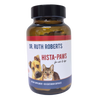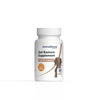As a pet parent, I know how much we worry about our furry friends. Some of us focus on keeping their weight in check, while others are more concerned about unexpected weight or muscle loss. So, let’s tackle the question together: Is my cat fat? Is my dog fat? In this guide, I’ll share professional methods, easy ways to assess your pet’s weight, and the important difference between being fat and being obese.
Fat vs. Obese: What’s the Difference?
Many people use the terms "fat" and "obese" interchangeably, but they’re not the same. Understanding the distinction is key when assessing your pet’s health:
-
Fat:
Fat is a general, informal term to describe excess body weight. A pet may be slightly overweight and still described as “fat” without necessarily facing serious health risks. For example, a pet might have a little extra padding but still be able to move easily and maintain good muscle tone. -
Obese:
Obesity is a medical term that refers to excessive body fat to the point where it can harm your pet’s health. Obesity is more severe than being "fat" and is typically associated with measurable health risks, such as joint problems, diabetes, and heart issues.
How to Tell the Difference
To determine whether your pet is fat or obese, I recommend using tools like the Body Condition Score (BCS) and Muscle Condition Score (MCS) (explained below). These methods provide a more objective way to assess your pet’s weight and body composition, helping you distinguish between harmless weight gain and a potentially serious problem.
What Does Cat Obesity Look Like?
The Body Condition Score (BCS) is one of the most reliable tools to determine whether your pet is underweight, ideal, or overweight. This scoring system, developed by the World Small Animal Veterinary Association (WSAVA), uses a scale of 1 to 9.
Here’s how the scale works:
- 1 to 3: Too thin
- 4 to 5: Ideal (I find 4–4.5 to be the sweet spot for most cats and dogs).
- 6 to 9: Overweight to obese
When I assess a pet, I look for these signs of a healthy weight:
- Waistline from above: There should be a noticeable waist.
- Tuck in the abdomen from the side: The belly should curve upward slightly.
- Feeling the ribs: With gentle pressure, you should be able to feel your pet’s ribs without much effort.
If you’re not used to palpating your pet (feeling their body for these signs), don’t worry—it’s a skill that improves with practice. I recommend starting early or around midlife (5 years old for most pets) to monitor any changes before they escalate.
Is My Dog Obese? Understanding Muscle Condition
Body weight isn’t the only factor to consider—muscle condition is just as important. Pets can lose muscle even if their body fat remains the same, which makes this assessment crucial. The Muscle Condition Score (MCS) helps me evaluate this. I focus on three key areas:
- Spine and shoulder blades
- Hips (wings of the ilium)
- Muscles along the spine
Here’s what I’ve learned:
- A pet can be overweight but still lose muscle.
- A normal-weight pet can also experience muscle loss.
This distinction matters because it determines the care plan. For instance:
- A young, overweight dog with strong muscles might need an active weight-loss regimen.
- An older, overweight dog with muscle loss requires a gentler approach to avoid pain or further muscle loss.
How to Measure Cat and Dog Weight at Home
If you’re unsure how to palpate your pet, here’s an easy way to track their weight and muscle health using a soft tape measure (like one a seamstress would use). I recommend measuring the following areas:
- Waist circumference: Just in front of the rear legs.
- Chest circumference: Right behind the front legs (near the elbows).
- Rear leg muscles: Around the thickest part of the rear leg near the groin.
- Biceps circumference: Around the upper leg near the armpit.
By recording these measurements over time, you’ll notice any significant changes. For example, if your dog’s rear leg muscles seem thinner, measure and compare it to earlier records. If there’s a drop, like losing three inches in muscle circumference, it’s time to consult your vet.
Healthy Weight for Cats and Dogs: What You Need to Know
Maintaining a healthy weight and muscle mass requires a combination of:
- Nutrition: A fully balanced diet tailored to your pet’s age and lifestyle.
- Exercise: Activities that match your pet’s condition and energy levels.
- Regular monitoring: Consistently checking your pet’s body and muscle condition.
Remember, keeping your pet lean isn’t just about preventing obesity—it’s about improving their quality of life and longevity.
How to Tell if Your Dog or Cat Is Obese
If you’re still unsure whether your pet’s weight is healthy, here’s a quick recap:
- Look for a defined waistline and an abdominal tuck.
- Feel for their ribs—gentle pressure should suffice.
- Use a tape measure to track changes in their body and muscle circumference.
And if you notice any drastic changes, don’t hesitate to visit your vet.
Watch the Full Video for More Tips
If you’re curious to see these techniques in action, check out the video above where I explain how to use the Body Condition Score and Muscle Condition Score to assess your pet’s health. With these tools, you’ll feel more confident in helping your pets stay lean, strong, and healthy for years to come.
















